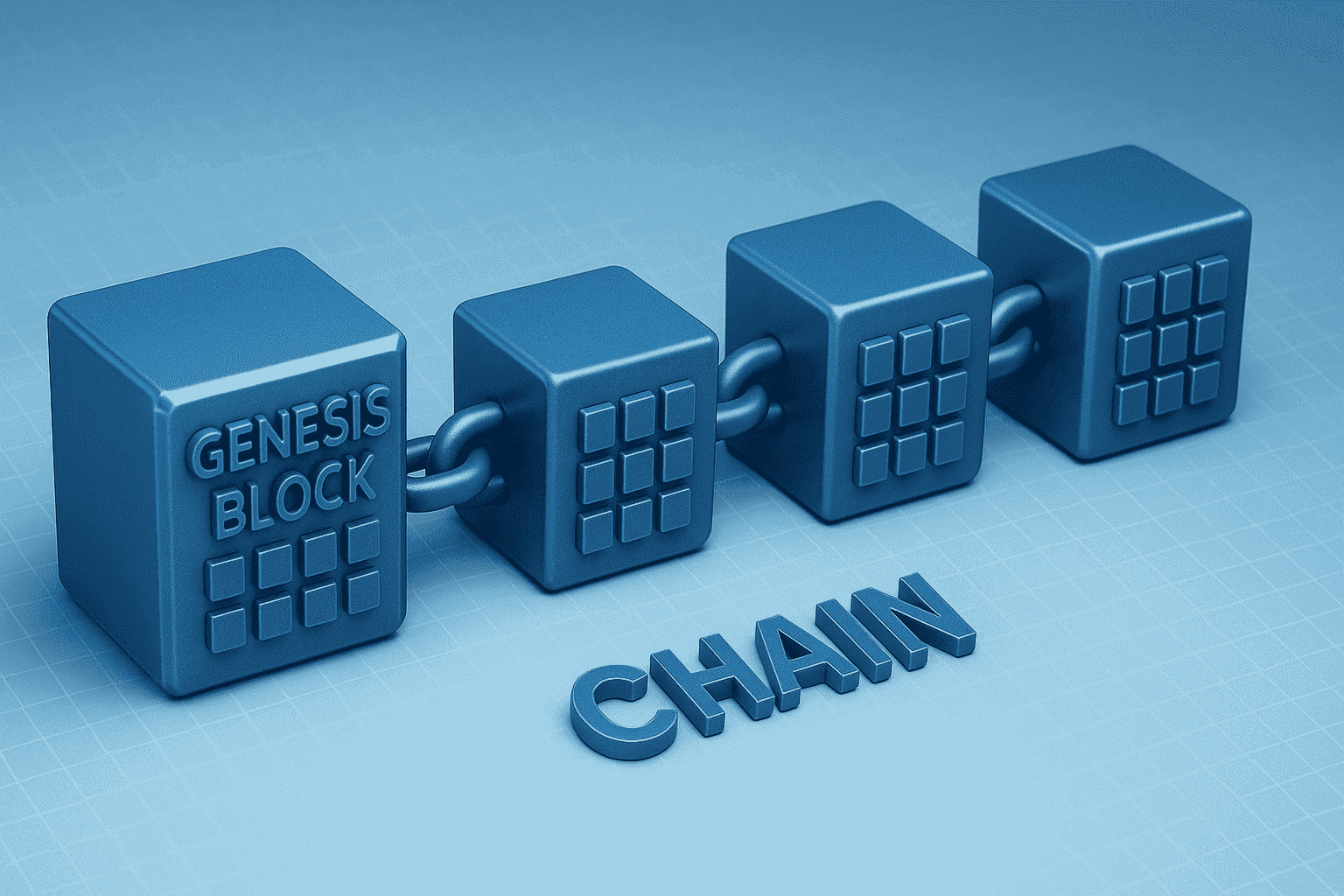A blockchain is a distributed database where records (“blocks”) are cryptographically linked into an immutable chain. This core mechanism underpins cryptocurrencies, decentralized applications, and digital assets. In this article, we examine every stage: from the creation of the very first genesis block through the dynamic growth of the chain, covering block structure, consensus mechanisms, fork handling, SPV clients, scaling solutions, and security considerations.
1. The Genesis Block: The Chain’s Inception
1.1 What Is the Genesis Block?
The genesis block is the first block in any blockchain. It is unique because its Previous Block Hash field contains a special value (typically zero or a predefined marker), initializing the chain and defining the network’s starting state.
1.2 Examples of Genesis Blocks
- Bitcoin: Mined on January 3, 2009, it famously contains the message “The Times 03/Jan/2009 Chancellor on brink of second bailout for banks.”
- Ethereum: Launched on July 30, 2015, preloading a set of initial accounts and contracts.
- Litecoin: Created October 13, 2011, as “silver to Bitcoin’s gold,” it mirrors Bitcoin’s genesis timestamp with a similar embedded message.
2. Block Structure
2.1 Block Header
Each block begins with a header containing essential metadata:
| Field | Description |
|---|---|
| Version | Protocol version |
| Previous Block Hash | Hash of the prior block |
| Merkle Root | Root hash of the block’s Merkle tree |
| Timestamp | Block creation time (Unix time) |
| Difficulty Target | Compressed target threshold |
| Nonce | Value miners change to find a valid hash |
2.2 Block Body: Transactions & Merkle Tree
The rest of the block lists transactions arranged into a Merkle tree for efficient proof of inclusion:
- Hash each transaction → leaves;
- Pairwise concatenate and hash → upper-level nodes;
- Repeat until a single Merkle Root remains.
This allows SPV clients to verify a transaction with O(log n) proofs.
3. Linking Blocks into a Chain
3.1 Forming the Chain
Each block’s Previous Block Hash references its parent, creating a continuous, tamper-evident chain:
- Cryptographic hashes ensure one-way links.
- Any alteration to a block changes its hash, invalidating successors.
3.2 Attack Scenario
To rewrite history, an attacker must redo PoW for every subsequent block and catch up to honest miners—a near-impossible feat in a widely distributed network.
4. Consensus Mechanisms
4.1 Proof of Work (PoW)
In PoW blockchains (Bitcoin, Litecoin), miners expend computing power to find a nonce that yields a header hash below the target. The first to succeed earns a block reward and the right to append the block.
- Difficulty adjusts every N blocks (2016 in Bitcoin) to maintain ~10-minute intervals.
- High energy consumption, but simple to verify.
4.2 Proof of Stake (PoS)
In PoS networks (Ethereum 2.0, Cardano), validators are chosen based on stake and lock-up duration. Benefits include:
- Much lower energy usage.
- A 51% attack requires owning the majority of coins.
4.3 Other Models
- Delegated PoS (EOS): elected delegates produce blocks;
- Proof of Authority (VeChain): trusted nodes sign blocks;
- Proof of History (Solana): a hash chain provides a time record.
5. Forks and Reorganizations
5.1 Soft vs. Hard Forks
- Soft Fork: backward-compatible upgrade (narrows valid rules).
- Hard Fork: non-compatible upgrade requiring all nodes to update.
5.2 Chain Reorganizations
If a longer chain appears, nodes switch to it, orphaning blocks on shorter branches and ensuring a single authoritative history.
6. SPV and Light Clients
6.1 Simplified Payment Verification
SPV clients store only block headers and Merkle proofs for relevant transactions, saving disk space and resources.
6.2 Trust and Risks
- Relies on honest full nodes to supply correct headers.
- Vulnerable to eclipse attacks if connected only to malicious peers.
7. Scaling Solutions
7.1 Layer-2 Techniques
- Lightning Network: payment channels for instant Bitcoin micropayments.
- Optimistic Rollups: batch transactions off-chain, publish summaries on Ethereum L1.
- zk-Rollups: use zero-knowledge proofs to optimize verification.
7.2 Sharding
In PoS systems like Ethereum 2.0, sharding partitions the state into parallel chains (shards) to boost throughput.
8. Security and Future Outlook
8.1 51% Attacks
In PoW, an attacker needs majority hash power; in PoS, majority stake—both scenarios are economically prohibitive in large networks.
8.2 Protection Against Deep Reorgs
- Waiting for 6 confirmations is standard in PoW to mitigate deep reorgs.
- PoS networks use finality checkpoints to lock in history.
9. Case Studies: Bitcoin vs. Ethereum
9.1 Parameter Comparison
| Parameter | Bitcoin | Ethereum |
|---|---|---|
| Genesis | Jan 3, 2009 | Jul 30, 2015 |
| Block Time | ≈10 min | ≈12–14 s |
| Consensus | PoW (SHA-256) | PoS (Beacon Chain) |
| Scaling | Lightning Network | Rollups, Sharding |
10. Conclusion
From the genesis block through the ever-growing chain, blockchains employ cryptographic linking, consensus mechanisms, and fork handling to guarantee data immutability and security. Light clients, Layer-2 solutions, and sharding address scalability. Understanding this architecture is essential for developers, investors, and users in the blockchain ecosystem.





















